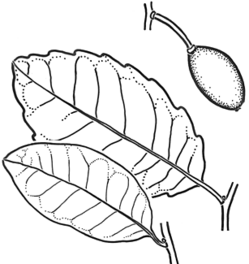Common name: yellow tulipwood, greybark, yellow yulip, grey boxwood, white myrtle, grey bark
Drypetes deplanchei (Brongn. & Gris) Merr. APNI* Synonyms: Elaeocarpus deplanchei Brongn. & Griseb. APNI*
Drypetes deplanchei subsp. affinis (Pax & K.Hoffm.) P.S.Green APNI*
Drypetes australasica (Müll.Arg.) Pax & K.Hoffm. APNI*
Drypetes lasiogyna var. australasica (Müll.Arg.) Airy Shaw APNI*
Drypetes affinis Pax & K.Hoffm. APNI*
Drypetes deplanchei (Brongn. & Griseb.) Merr. subsp. deplanchei APNI*

Description: Small to medium-sized tree, glabrous.
Leaves ± ovate, 4–9 cm long, 1–5 cm wide, stiff, margins toothed or crenate to ± entire, prickly-toothed in juvenile stages, glabrous, venation prominent; petiole 6–10 mm long.
Male flowers in axillary racemes; perianth c. 2 mm long, stamens 5–10. Female flowers in clusters of 3 or 4 or solitary, c. 3 mm long.
Fruit ovoid, 10–20 mm long, orange to red, fleshy; ripe February–April.
Distribution and occurrence: in coastal rainforest north from Dungog.
NSW subdivisions: NC, LHI
Other Australian states: Qld N.T. W.A.
Drypetes was formerly included in Euphorbiaceae.
Text by T.A. James & G.J. Harden, Flora of New South Wales Vol. 1: 394–395 (1990), as Drypetes australasica
Taxon concept: Australian Plant Census (accessed May 2017)
APNI* Provides a link to the Australian Plant Name Index (hosted by the Australian National Botanic Gardens) for comprehensive bibliographic data
***The AVH map option provides a detailed interactive Australia wide distribution map drawn from collections held by all major Australian herbaria participating in the Australian Virtual Herbarium project.
|


